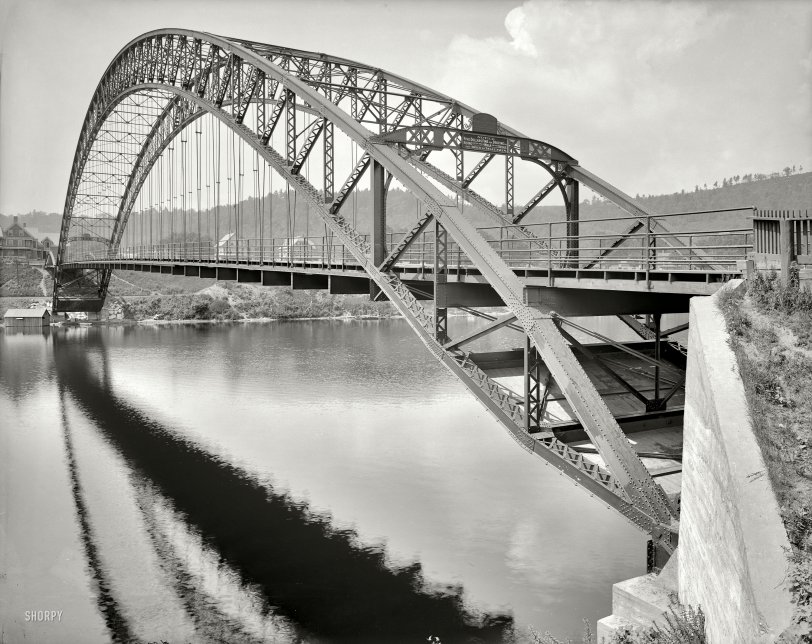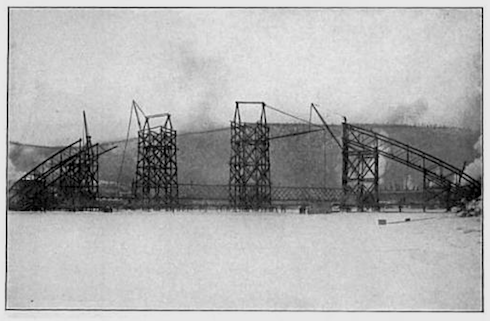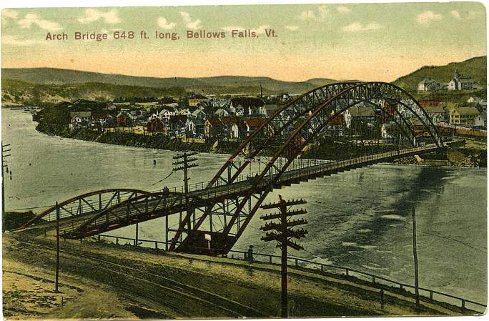


Framed or unframed, desk size to sofa size, printed by us in Arizona and Alabama since 2007. Explore now.
Shorpy is funded by you. Patreon contributors get an ad-free experience.
Learn more.

- Indiana Harbor Belt abides
- Freezing haze
- Corrections (for those who care)
- C&NW at Nelson
- Fallen Flags
- A dangerous job made worse
- Water Stop
- Passenger trains have right of way over freights?
- Coal
- Never ceases to amaze me.
- Still chuggin' (in model form)
- Great shot
- Westerly Breeze
- For the men, a trapeze
- Tickled
- Sense of loneliness ...
- 2 cents
- Charm City
- What an Outrage
- Brighton Park
- Catenary Supports
- Just a Little Before I was Born
- Afternoon normal
- The Flat Iron Cafe survives
- Aging in Place
- Raise your hand
- Good and Bad
- Oh, the 70's
- Nooooooi
- The aluminum tubing
Print Emporium
Slow Bridge: 1908

Circa 1908. "Arch bridge, Bellows Falls, Vermont." Note the $5 fine for speeders. 8x10 inch dry plate glass negative, Detroit Publishing Company. View full size.
Bellows Falls Arch-Bridge
Minutes of Proceedings, American Society of Civil Engineers, 1908.Erection of the Bellows Falls Arch-Bridge
by L. D. Rights.
This bridge, which is a steel arch with suspended floor, is only surpassed in span in the United States by the two deck-arches over the Niagara gorge. It spans the Connecticut River at Bellows Falls, dividing the States of New Hampshire and Vermont. It is about 650 feet long and consists of a single, three-hinged arch span, 540 feet from centre to centre of end pins, with a short truss-span at one end, 104 feet 8 inches from centre to centre of bearings. The height of the main arch is 90 feet between the hinge-centres, and the truss-booms follow the lines of two parabolas 14 feet apart, the two trusses being parallel from end to end, 30 feet apart. This provides for a roadway 20 feet wide and a footpath 6 feet wide. The steel used in the construction of the arch-ribs has an ultimate strength of 60,000 lbs. per square inch. One of the most interesting features in the design is the arrangement adopted at the middle of the arch. Instead of bringing the booms together to a pin, the horizontal thrust is taken by a short strut composed of two 15-inch channels, and this thrust is then divided into four parts at the intersection of the diagonals in the panels next to the centre. By this method the arch appears continuous, which adds to its appearance, and the pin is dispensed with. The floor was cambered 18 inches at the centre of the arch.
The erection of the arch was accomplished by falsework composed of six towers resting on spruce piles driven 8 or 10 feet into the bed of the river, which were cut off and capped 3 feet above low water line, the water being about 25 feet deep. During erection ice formed on the river to a thickness of 2 feet, on which the booms were assembled ready to be hoisted into place by the derrick-booms on the top of the wooden towers. When the steelwork was joined at the centre it was found that instead of the calculated 3 inches of fillers, 1½ inch was required. When the halves were connected up the work was bolted together, and with no load but the weight of the arch, the settlement at the crown was reported to have been 1½ inch. The erection of the trusses took 28 days, during part of which time the temperature was 0° F. The falsework was then removed and the floor system put in place. The rivets were all driven by hand, eight gangs of four men each being employed. The weight of the steel in the main arch was 450 tons, the contract price for the masonry being £1,250 [$6,000] and for the superstructure £8,500 [$41,000].
British abstract of "Erection of the Bellows Falls Arch Bridge" [Google Book Link, more photos, technical data]

Span with a Plan
Now that is a handsome bridge. Today we get ugly slabs and if they choose to get fancy, the result looks like some strange stringed musical instrument.
The Old Bridge
Great shot. As a life long resident of North Walpole, New Hampshire, I walked this bridge many a time over to Bellows Falls when I was kid. This is actually one of the few photographs that I've seen taken from "our" side of the bridge. As mentioned above demo crews failed on many attempts to bring her down. Ultimately, I believe, the bridge was cut down with torches.
Demolition
I grew up in a neighboring town and we went down to see the demolition of this bridge in the early 1980s. Someone had determined that it was unsafe, so we lined the river and waited for the explosion. They detonated the charges and the bridge didn't move. It was a bit stronger than they thought! In the end, it took them about five tries.
Long and Strong
According to Wikipedia this was the longest arch bridge in the country when it opened in 1905. It had no piers in the water and the span over water was 540 feet. It was destroyed in 1982. The bridge was much stronger than the demolition crew planned for. It took them 5 tries to bring the bridge down.
Gorgeous!
This is one of the few pics I've actually saved for my desktop-picture collection. Beautiful bridge, beautifully photographed.
1905 - 1982
Built 1905
Damaged by flooding in 1936
Closed to traffic 1971
Demolished 1982
Designed By: J.R. Worchester

An expensive ticket!
Calculating for inflation, the $5 fine in 1905 equates to $120 today -- a hefty fine! Of course, I guess they would have to give you some leeway if you crossed the bridge while "power walking."
























On Shorpy:
Today’s Top 5